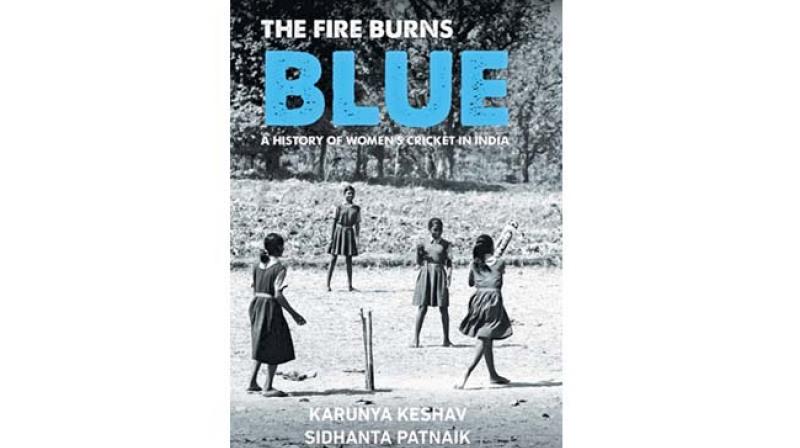Book Review: The girls call the shots

‘I can’t digest defeat. I am a very bad loser. There have been times when I got sleepless nights because of it.’ All-rounder Jhulan Goswami.
Over a decade ago, if you were asked at a quiz competition to name at least five India international women cricketers, you may have struggled to get past Shantha Rangaswamy and Diana Eduljee. Times have changed. Today, Mithali Raj, Harmanpreet Kaur, Anjum Chopra, Jhulan Goswami and Smriti Mandhana trip lightly off most cricket aficionados’ tongues. Perhaps not quite in the same way Tendulkar, Dhoni and Kohli do but still, it’s something. Women’s cricket in India and indeed the world, has come a long way.
How this transformation came about, the enormous struggles involved, the biases one had to confront, public apathy and its slow turnaround, showcasing their talent to the world - all this, in a nutshell is what The Fire Burns Blue - A History Of Women’s Cricket In India, the book recently released is all about.
Dedication, attention to detail, meticulous planning and a passion for the game, is what we expect of our cricketers - men or women. Those are the very qualities the authors of this excellent tome, Karuna Keshav and Sidhanta Patnaik bring to bear in tracing the history of women’s cricket in India.
The Fire Burns Blue is a book that was waiting to be written for some time now. Serendipitously or otherwise, now is as good a time as any for its release. The book, by association, might have burned even brighter had our girls managed to win the World Cup ODIs in England in 2017, which they so agonisingly and narrowly failed to do in the final at Lord’s against the host nation. Lord’s!
Another toothy-smile, Kapil Dev’s 1983 Prudential Cup moment or Sourav Ganguly’s NatWest 2002, shirt-waving frieze was within Mithali Raj’s grasp, only to slip away by the slimmest of margins. Agony was snapping at the heels of Ecstacy, the latter succumbing. It’s a telling moment in our history of women’s cricket, captured with eloquence and empathy by the authors. In a broad sweep, the book covers over four decades in the history of women playing what was largely regarded a man’s game in our country.
From one small step in 1971, when the girls didn’t even get the proverbial two coins to rub together for representing India, to riches beyond avarice as the new millennium dawned under the tender ministrations of the Board of Control for Cricket in India (BCCI). A game that was largely controlled by the Women’s Cricket Association of India (WCAI) for much of its history, coming under the BCCI’s benevolentembrace was a much needed boost for women’s cricket. Not that everything ran smoothly for this happy state of affairs to come about.
The redoubtable former BCCI President and strongman, N. Srinivasan apparently had no time for women’s cricket and had all but turned his face against it. Other prominent BCCI bosses barely paid lip service. The young politico-President, Anurag Thakur is portrayed as the knight in shining armour who came to the rescue of India’s women cricketers when it was most needed.
The authors take us through the economics and politics of the WCAI and cricket in general with great delibeation, paying careful attention to a chronological denouement.As is to be expected, the book is swollen with statistics, and to a lay reader, even if interested in cricket, the plethora of figures can be a bit numbing. For the most part, however, the numbers pass us by in a blur. What we retain are the flesh and blood people - the cricketers, the administrators, the coaches, the families - all of whom had to deal with myriad issues over the decades concerning girls taking to the game. Interruption of education, diet and nutrition issues, physical and psychological training unique to the gentler sex, struggles to gain acceptance and even menstrual problems are discussed with an easy candour that is frank and refreshing.
While the players themselves are the obvious heroines, those behind the scenes - the support from families and coaches, whose names will never be up in lights, are the silent warriors who have taken the women’s game to where it is today. Keshav and Patnaik have done a sterling job in highlighting the lesser known aspects of the women’s game, and for that alone, the book is worth adding to your library.In a country, where women have been treated as second class citizens for centuries, never mind the ‘Bharat Mata’ moniker, the last few decades have seen Indian women rise slowly but surely to higher echelons, be it in Politics, Business, the Arts or Sport.
The book characterises the overweening importance of today’s stars Mithali and Jhulan, joined at the hip and dubbed the ‘Miljhul’ phenomenon. That the game of cricket in India is as much a religion as a passion, is a well-worn cliché. In the deft and articulate hands of Karuna Keshav and Sidhanta Patnaik, The Fire Burns Blue strikes an elegant blow for women’s power through their engaging recounting of the travails and triumphs of women’s cricket in India.
Writer’s note: I acknowledge that the headline for this review is taken from one of the chapter heads of the book.
(The author is a brand consultant with an interest in music, cricket, humour and satire)

